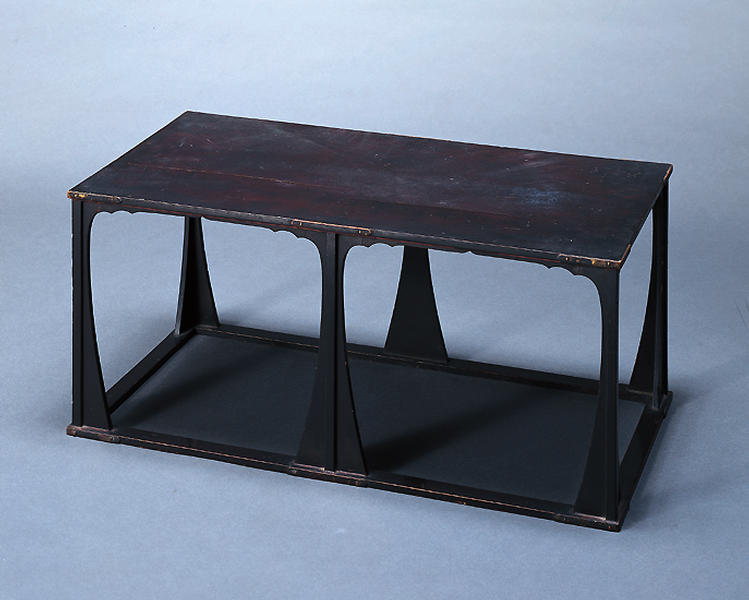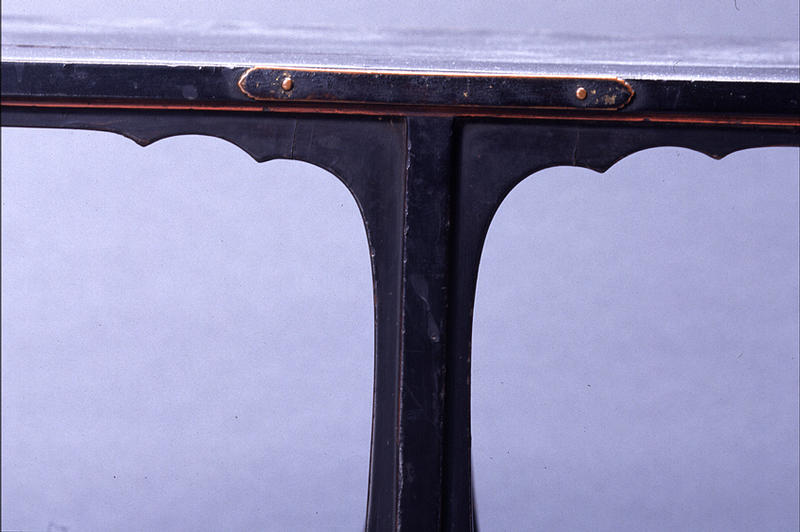黒漆塗前机
- 室町時代
- 15-16c
- 木製黒漆塗、金銅製金具
- H-32.2 D-36 W-73.1
- 所蔵
- 安養寺伝来(什器)
室町時代 15-16世紀
高:31.9cm 幅:73.1cm 奥行:37.0cm
束で左右二区に仕切った長側面には,二面のいずれにも二つ,短側面にはそれぞれ一つの蓮華形(合掌形)格狭間を透かす,ヒノキ材製長方形の総体黒漆塗前机である。この形状の机は,鎌倉時代に比定される法隆寺講堂所用の事例のように丈高にしつらえられている場合は,仏前にすえて火舎香炉を中心に六器・花瓶・燭台などの一面具や三具足などの法具類を置用する前机として使用されることもある。しかし,一般的には磬架などと同様,僧侶の座す礼盤の脇に配し,柄香炉や香入といった香具,あるいは据箱や戒体箱の類を置く脇机とされるのが通例であり,この机も背丈が比較的低いことから脇机とされてきた可能性が高い。
薄手に仕上げた天板や畳擦り(下框)の造作,繊細な感覚を示す脚部の形姿や持ち送りの刳り形など,いずれも製作に携わった工人の洗練された美意識を示している。
要所に装着した八双形金具は金銅素文。木組みの一部に朱漆を塗布,黒一色のなかに界線を際立たせるのもこの種の机の常套である。
刳り形を施した羽目板や脚部に天板と塗り肌の異なるところや補修のための接合板の痕跡も認められるが,当初の全容をよく保つ佳品である。
天板裏に「安養寺常住也」の朱漆銘を記しているが,いずれの安養寺であるかは詳らかでない。(河田)
Catalogue Entry
Muromachi period, 15th to 16th centuries
Black lacquered wood
Height, 31.9cm; width, 73.1cm; depth, 37.0cm
Each of the long sides of this altar table have been divided by a central leg into 2 panels of lotus blossom-shaped openwork (joined hands-shape), and each of the short sides of the table is fitted with a single panel of this openwork design. The hinoki (Japanese cypress) rectangular structure is coated overall with black lacquer. This form of table can be seen in examples used in the lecture hall of Horyuji said to date from the Kamakura period, and tall examples of this table form are used as altar tables placed directly in front of the central image of a temple. This frontal table holds Buddhist implements, with an incense brazier in the center and flanked on either side by such implements as rokki bowls, flower vases, candle stands, etc. Generally, however, these tables are used as side tables placed to the side of the seat of the presiding priest, in the same manner as the gongs used in the rituals. These side tables hold various incense implements, such as a handled incense burner, incense container, etc., or ichimengu, mitsugusoku, or other types of equipment. The present table is relatively short in stature, and thus was very likely used as this form of side table.
The manner in which the top surface of the table has been thinly formed and the lower framework created, the delicate forms of the legs, and the carving methods all point to the refined aesthetics of a particularly accomplished craftsman.
The metal fittings are made in a paired hasso-form and are made of gilt bronze with rough patterns. Part of the woodwork has been deco-rated with red lacquer, and the boundary lines set out against the overall black lacquer coating are conventional for this type of table.
While the lacquered surfaces of the carved side panels and the legs differ from those of the top surface board, and connected traces used for repair are also apparent, the overall original form of this superb table has been well maintained.
The bottom of the top board has been inscribed "Anyoji Joju nari" (commonly-used object in Anyoji) in red lacquer, but it is not clear which temple by the name of Anyoji is indicated. SK

